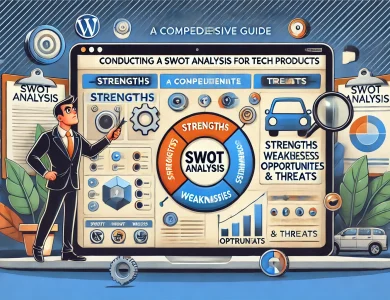Best Practices for Market Analysis in Product Management

In today’s rapidly evolving business landscape, market analysis is a foundational aspect of any successful product management strategy. It plays a crucial role in understanding customer needs, market trends, and competitive dynamics.
For a product manager, market analysis isn’t just about gathering data—it’s about using that data strategically to drive product decisions that align with long-term business goals, boost customer satisfaction, and set the company up for scalable growth.
In this article, we’ll explore best practices for conducting market analysis in product management, the role of leadership in fostering data-driven cultures, and how insights from analysis can shape product innovation, global strategy, and more.
What is Market Analysis in Product Management?
Market analysis is a process of gathering and interpreting data about a market, including customer behavior, competitor activity, economic trends, and technological advancements. For product managers, it informs product development, roadmap decisions, and strategic initiatives.
Key takeaway: A well-executed market analysis is more than just looking at customer behavior. It should inform strategic decisions at both the product level and executive level.
Key Components of Market Analysis
1. Market Segmentation: Dividing the market into distinct groups based on demographics, behavior, or needs. This informs how you position your product and which market segments to prioritize.
2. Competitive Analysis: Assessing the strengths and weaknesses of current and potential competitors. This allows product teams to spot market gaps and capitalize on competitor missteps.
3. Customer Behavior Analysis: Tracking and analyzing how customers interact with the product, their preferences, pain points, and overall engagement levels. This is crucial for aligning the product with actual user needs.
4. Market Trends: Analyzing shifts in consumer behavior, technological advancements, and regulatory changes that impact the market landscape. For example, AI advancements are drastically changing the product management landscape, and adapting to these shifts is key for sustained growth.
The Role of Market Analysis in Product Development
Market analysis helps product managers make data-driven decisions that not only meet current customer demands but also anticipate future needs. Whether you’re deciding which features to develop next or figuring out how to position your product in the market, market analysis provides the insights needed to align product efforts with market opportunities.
As a CEO, this ensures that your product development aligns with both immediate market needs and the company’s long-term strategic vision.
Understanding Market Segmentation
Market segmentation involves dividing a broad market into smaller groups with shared characteristics. It helps in tailoring your product messaging, features, and positioning to specific segments.
For example:
- A B2B SaaS company might segment its market into small businesses, mid-sized enterprises, and large corporations, each with its own set of product needs and budget constraints.
The effectiveness of market segmentation lies in how well product managers and marketers can craft targeted strategies for each segment. This is where collaboration between marketing and product teams becomes critical.
Common Challenges in Market Analysis
- Data Quality: Inaccurate or outdated data can skew results, leading to poor decision-making.
- Changing Market Conditions: Markets evolve quickly. What worked yesterday may not work today, especially in fast-paced industries like tech.
- Complexity of Data Interpretation: Large volumes of data from multiple sources can be overwhelming. This is where AI-driven analysis tools can add value by simplifying complex data into actionable insights.
Steps to Conduct a Comprehensive Market Analysis
- Define Objectives: Identify what you want to learn from the analysis. Are you looking to enter a new market, refine a product offering, or monitor competitors?
- Collect Data: Gather data from diverse sources such as surveys, customer feedback, sales data, industry reports, and competitive intelligence.
- Analyze and Segment: Segment your market by identifying patterns in the data, understanding customer behavior, and identifying competitive opportunities.
- Interpret and Apply Findings: Use the analysis to inform your product strategy, prioritizing features, expanding into new markets, or refining your product’s positioning.
- Continuous Monitoring: Market analysis is not a one-time activity. Consistently monitor your market to stay ahead of changes.
Leveraging AI for Market Analysis

For CEOs and product leaders, AI-powered tools are revolutionizing market analysis. AI can automate data collection, analyze large datasets for trends, and predict future market movements with predictive analytics. By doing so, it not only improves decision-making but also ensures that companies remain proactive rather than reactive.
For example:
- Predictive models can anticipate customer needs, making it easier for product managers to prioritize features that customers will demand in the future.
By incorporating AI into market analysis, companies can achieve real-time insights, which is crucial in today’s fast-paced tech industry.
Integrating Customer Insights into Market Analysis
While AI tools can help process data, human insights—especially from customer feedback—are invaluable. Engage directly with customers through surveys, focus groups, or usability testing to ensure that your product aligns with actual customer needs.
Key points:
- Customer feedback bridges the gap between data-driven insights and real-world applications.
- Always ensure that your product teams and marketing teams work together to extract actionable insights from customer interactions.
Using Competitive Analysis as a Part of Market Analysis
Understanding what your competitors are doing is critical. A comprehensive SWOT analysis of both your product and your competitors’ products can reveal gaps in the market that your product can fill.
For example:
- If a competitor lacks a key feature, you could prioritize that feature in your product development, positioning your product as a superior alternative.
Competitive insights should also inform your marketing and sales strategies, ensuring alignment across the organization.
Predictive Analytics in Market Analysis
Predictive analytics uses historical data to predict future outcomes. For product managers, this means being able to anticipate customer behavior, market shifts, and even potential product success. Using predictive models, you can better allocate resources and make informed decisions about where to invest your time and effort.
Scenario Planning and Market Analysis
For CEOs, it’s crucial to look beyond the present. Scenario planning allows companies to test various market conditions (e.g., economic downturns, competitor actions) and see how these scenarios would impact product strategy. By planning for different scenarios, companies can develop robust strategies that hold up under various market conditions.
Continuous Market Monitoring and Adaptation
Market analysis shouldn’t be treated as a one-time event. Markets evolve, and companies that fail to adapt can quickly fall behind. Regularly updating your market analysis ensures that your product strategy stays relevant.
For example:
- A startup may need to track shifting customer expectations or changes in consumer behavior, ensuring that their product evolves in line with market demands.
Best Practices and Practical Examples
Best Practices for Conducting Market Analysis in Product Management
- Define Clear Objectives: Know what you want to achieve from your market analysis—whether it’s entering a new market, refining your product, or monitoring competitors.
- Use the Right Tools: Leverage AI-driven tools that can provide real-time insights and predictive analytics.
- Collaborate Across Teams: Involve cross-functional teams in the analysis process, ensuring alignment between marketing, sales, and product development.
Case Study: Successful Market Analysis Leading to Product Success
Consider a SaaS company that successfully expanded into new global markets by conducting thorough market analysis. They used AI tools to monitor market trends, identified new customer segments, and prioritized product features based on predictive models. This allowed them to launch a product with minimal risk and maximum impact.
Tools for Effective Market Analysis
- AI-Powered Platforms: Tools like Tableau or Mixpanel provide deep insights into customer behavior and market trends.
- SWOT Analysis Tools: Use tools like Creately to create visual SWOT matrices and analyze competitor positioning.
- CRM Systems: Tools like Salesforce help capture and analyze customer data, aligning insights with product strategies.
Aligning Market Analysis with Business Strategy
Market analysis must align with the overall business strategy. Insights should not only inform product development but also shape go-to-market strategies, help with global expansion, and inform leadership decisions.
For CEOs, this alignment ensures that market analysis becomes an essential part of the company’s growth strategy, driving product innovation, customer satisfaction, and competitive advantage.
Conclusion
Market analysis is a vital component of product management that informs not only product strategy but the entire company’s direction. Whether you’re a product manager making daily decisions or a CEO looking to ensure long-term growth, a comprehensive and data-driven approach to market analysis will set your company up for success.
By adopting best practices, leveraging AI, and aligning analysis with business goals, companies can ensure their products stay competitive and meet customer demands in a rapidly changing marketplace.

